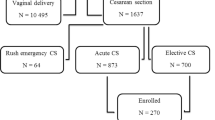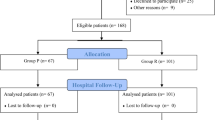Abstract
Purpose
Primary objective was to assess whether oral analgesia with oxycodone offers superior pain relief after cesareans than patient controlled analgesia (PCA). Secondary outcomes were additional pain medication, time to first mobilization, therapeutic side effects, postoperative restrictions, overall satisfaction and costs.
Materials and methods
Randomized controlled trial at a University Hospital conduct between July 2009 and November 2009. Of the 1,112 patients, 257 met the inclusion criteria and 239 agreed to participate. Patients were randomly assigned to either receive intravenous piritramide PCA (2 mg piritramide/ml 0.9 % saline) or oral oxycodone (20 mg). Pain was assessed on a visual analog pain scale (VAS) at 2, 12, 24, 32, 40, 48 and 72 h after cesarean.
Results
No differences in VAS scores were observed within the general study population. Pain scores of oxycodone versus PCA were comparable at 24 h. Patients randomized to PCA demonstrated increased demand for rescue medication 48 h after cesarean (p = 0.057). In the PCA group, patients with previous cesarean had increased operative times, a trend towards increased VAS scores after 48 h (p = 0.081) and increased VAS scores in comparison to patients who did not have cesarean before (p = 0.044). For this subgroup, no difference was seen in the oxycodone patients (p = 0.883).
Conclusion
General satisfaction with both treatment regimes was high. The results support the potential use of oral pain regimes and emphasis the importance of a multimodal approach to treat post-cesarean pain. Oral oxycodone is a not expensive, convenient and comparable analgesic to PCA devices with opioids after cesarean. Trial registration at clinicaltrials.gov identifier: NCT 01115101.




Similar content being viewed by others
References
Stamer UM, Wiese R, Stuber F, Wulf H, Meuser T (2005) Change in anaesthetic practice for caesarean section in Germany. Acta Anaesthesiol Scand 49(2):170–176
Van den Bussche E, Crombez G, Eccleston C, Sullivan MJ (2007) Why women prefer epidural analgesia during childbirth: the role of beliefs about epidural analgesia and pain catastrophizing. Eur J Pain 11(3):275–282
Landau R, Kraft JC, Flint LY, Carvalho B, Richebe P, Cardoso M, Lavand’homme P, Granot M, Yarnitsky D, Cahana A (2010) An experimental paradigm for the prediction of post-operative pain (PPOP). J Vis Exp (35)
Kehlet H, Jensen TS, Woolf CJ (2006) Persistent postsurgical pain: risk factors and prevention. Lancet 367(9522):1618–1625
Katz J, Poleshuck EL, Andrus CH, Hogan LA, Jung BF, Kulick DI, Dworkin RH (2005) Risk factors for acute pain and its persistence following breast cancer surgery. Pain 119(1–3):16–25
Bystrova K, Ivanova V, Edhborg M, Matthiesen AS, Ransjo-Arvidson AB, Mukhamedrakhimov R, Uvnas-Moberg K, Widstrom AM (2009) Early contact versus separation: effects on mother–infant interaction one year later. Birth 36(2):97–109
Willmann S, Edginton AN, Coboeken K, Ahr G, Lippert J (2009) Risk to the breast-fed neonate from codeine treatment to the mother: a quantitative mechanistic modeling study. Clin Pharmacol Ther 86(6):634–643
Declercq E, Cunningham DK, Johnson C, Sakala C (2008) Mothers’ reports of postpartum pain associated with vaginal and cesarean deliveries: results of a national survey. Birth 35(1):16–24
Eisenach JC, Pan PH, Smiley R, Lavand’homme P, Landau R, Houle TT (2008) Severity of acute pain after childbirth, but not type of delivery, predicts persistent pain and postpartum depression. Pain 140(1):87–94
Wu CL, Naqibuddin M, Rowlingson AJ, Lietman SA, Jermyn RM, Fleisher LA (2003) The effect of pain on health-related quality of life in the immediate postoperative period. Anesth Analg 97(4):1078–1085 (table of contents)
Derrode N, Lebrun F, Levron JC, Chauvin M, Debaene B (2003) Influence of peroperative opioid on postoperative pain after major abdominal surgery: sufentanil TCI versus remifentanil TCI. A randomized, controlled study. Br J Anaesth 91(6):842–849
Seaton S, Reeves M, McLean S (2007) Oxycodone as a component of multimodal analgesia for lactating mothers after Caesarean section: relationships between maternal plasma, breast milk and neonatal plasma levels. Aust N Z J Obstet Gynaecol 47(3):181–185
Embroyotox.de (2009) Arzneimittelsicherheit in Schwangerschaft und Stillzeit. http://www.embryotox.de/oxycodon.html
Coutinho IC, Ramos de Amorim MM, Katz L, Bandeira de Ferraz AA (2008) Uterine exteriorization compared with in situ repair at cesarean delivery: a randomized controlled trial. Obstet Gynecol 111(3):639–647
Hofmeyr GJ, Mathai M, Shah A, Novikova N (2008) Techniques for caesarean section. Cochrane Database Syst Rev (1):CD004662
Nafisi S (2007) Influence of uterine exteriorization versus in situ repair on post-cesarean maternal pain: a randomized trial. Int J Obstet Anesth 16(2):135–138
Chang SH, Maney KM, Phillips JP, Langford RM, Mehta V A comparison of the respiratory effects of oxycodone versus morphine: a randomised, double-blind, placebo-controlled investigation. Anaesthesia 65(10):1007–1012
Mercadante S, Tirelli W, David F, Arcara C, Fulfaro F, Casuccio A, Gebbia V Morphine versus oxycodone in pancreatic cancer pain: a randomized controlled study. Clin J Pain 26(9):794–797
Michaelis R, Berger R (2007) Basic conditions for a neurological examination for 0–2 year olds: a consensus suggestion. Monatsschrift Kinderheilkunde 155(6):506–513
Rosenberg WF, JM (2002) Randomization in clinical trials. Wiley, New York
Davis KM, Esposito MA, Meyer BA (2006) Oral analgesia compared with intravenous patient-controlled analgesia for pain after cesarean delivery: a randomized controlled trial. Am J Obstet Gynecol 194(4):967–971
McDonnell NJ, Paech MJ, Browning RM, Nathan EA (2010) A randomised comparison of regular oral oxycodone and intrathecal morphine for post-caesarean analgesia. Int J Obstet Anesth 19(1):16–23
Jakobi P, Solt I, Tamir A, Zimmer EZ (2002) Over-the-counter oral analgesia for postcesarean pain. Am J Obstet Gynecol 187(4):1066–1069
Lundgren I, Dahlberg K (1998) Women’s experience of pain during childbirth. Midwifery 14(2):105–110
Owen H, Plummer JL, Armstrong I, Mather LE, Cousins MJ (1989) Variables of patient-controlled analgesia. 1. Bolus size. Anaesthesia 44(1):7–10
Dahl JB, Jeppesen IS, Jorgensen H, Wetterslev J, Moiniche S (1999) Intraoperative and postoperative analgesic efficacy and adverse effects of intrathecal opioids in patients undergoing cesarean section with spinal anesthesia: a qualitative and quantitative systematic review of randomized controlled trials. Anesthesiology 91(6):1919–1927
Jakobi P, Weiner Z, Solt I, Alpert I, Itskovitz-Eldor J, Zimmer EZ (2000) Oral analgesia in the treatment of post-cesarean pain. Eur J Obstet Gynecol Reprod Biol 93(1):61–64
Hadar E, Melamed N, Tzadikevitch-Geffen K, Yogev Y (2010) Timing and risk factors of maternal complications of cesarean section. Arch Gynecol Obstet
Olsen MA, Butler AM, Willers DM, Devkota P, Gross GA, Fraser VJ (2008) Risk factors for surgical site infection after low transverse cesarean section. Infect Control Hosp Epidemiol 29(6):477–484 (discussion 485–476)
Wodlin NB, Nilsson L, Arestedt K, Kjolhede P (2011) Mode of anesthesia and postoperative symptoms following abdominal hysterectomy in a fast-track setting. Acta Obstet Gynecol Scand 90(4):369–379
Wodlin NB, Nilsson L, Kjolhede P (2011) Health-related quality of life and postoperative recovery in fast-track hysterectomy. Acta Obstet Gynecol Scand 90(4):362–368
Acknowledgments
The study was initiated and analyzed by the investigators.
Conflict of interest
All authors disclose any conflict of interests.
Author information
Authors and Affiliations
Corresponding author
Rights and permissions
About this article
Cite this article
Dieterich, M., Müller-Jordan, K., Stubert, J. et al. Pain management after cesarean: a randomized controlled trial of oxycodone versus intravenous piritramide. Arch Gynecol Obstet 286, 859–865 (2012). https://doi.org/10.1007/s00404-012-2384-5
Received:
Accepted:
Published:
Issue Date:
DOI: https://doi.org/10.1007/s00404-012-2384-5




